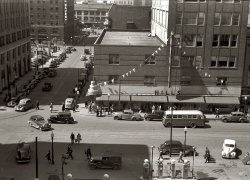
MAY CONTAIN NUTS

Search Shorpy
SHORPY ART

Framed or unframed, desk size to sofa size, printed by us in Arizona and Alabama since 2007. Explore now.
Join and Share
Ad-Free Shorpy
Shorpy is funded by you. Patreon contributors get an ad-free experience.
Learn more.

Recent comments
- Texas Flyer wanted
- Just a Year Too Soon
- WWII -- Replacing men with women at the railroad crossing.
- Yes, Icing
- You kids drive me nuts!
- NOT An Easy Job
- I wonder
- Just add window boxes
- Icing Platform?
- Indiana Harbor Belt abides
- Freezing haze
- Corrections (for those who care)
- C&NW at Nelson
- Fallen Flags
- A dangerous job made worse
- Water Stop
- Passenger trains have right of way over freights?
- Coal
- Never ceases to amaze me.
- Still chuggin' (in model form)
- Great shot
- Westerly Breeze
- For the men, a trapeze
- Tickled
- Sense of loneliness ...
- 2 cents
- Charm City
- What an Outrage
- Brighton Park
- Catenary Supports
Member Photos
The Shorpy
Print Emporium
Print Emporium
Search Shorpy
Search results -- 30 results per page
- Dramatic Entrance: 1940
- ... gold mining town." Acetate negative by Russell Lee for the Farm Security Administration. View full size.
The short way out If you ... Posted by Dave - 12/03/2020 - 9:40pm -
![Dramatic Entrance: 1940 May 1940. "Front of abandoned residence in Georgetown, New Mexico. Ghost gold mining town." Acetate negative by Russell Lee for the Farm Security Administration. View full size.
The short way outIf you think the entrance is dramatic then stay to watch the exits.
Not to be found nowGoogle maps doesn't even show a place called Georgetown, New Mexico now; just Georgetown road leading to Georgetown cemetery.
I'm sure this porch was intended to project prosperity and was frequently used as an outdoor sitting room during hot summers. My mother's family ranched (& still ranches) about 60 miles north of Georgetown. The front porch on the old house there is larger than this one, but not as ornate. During the summer my grandfather rolled his roll-top desk onto the front porch and conducted his business there.
At least the walls are well insulatedAdobe bricks are good for that.
SmallpoxThis site has some background on the place, other pics by Russell Lee and a shot of the only surviving relic, the cemetery. It mentions some reasons for the town's demise, a fire and a smallpox outbreak in 1892. Not long after that the Panic of 1893 finished it off.
Cord and shadowI see a cord or wire or line of some kind running horizontally along the base of the house, on the left, about a foot off the ground, and it appears to continue along the underside of the porch, past the stairs, and on to the right underside of the porch where it disappears. To complicate matters, I also see the shadow of a line running diagonally across the wall on the left, above the wire, and also cutting across the porch. Does anyone know what I am looking at?
[A barbed-wire fence. - Dave]
Oh, now I get it! No wonder the wire is out of focus – it's in the foreground. Thanks, Dave.
Just off screenBoris Karloff and Bela Lugosi.
Going, going, goneIt's interesting to compare topo maps from 1999, 1948, and 1909 (top to bottom.)
Location of the Georgetown CemeteryApparently the only thing left of this town:
https://goo.gl/maps/BeJ28rWeqV6JMrDP9
Interestingly, the apparent foundations of several buildings can be seen nearby when you switch to Satellite view.
(The Gallery, Mining, Russell Lee)](https://www.shorpy.com/files/images/SHORPY-8b25064a.thumbnail.jpg)
- Dust Bowl Boy: 1936
- ... Medium format nitrate negative by Arthur Rothstein for the Farm Security Administration. View full size. Arthur's daughter Annie ... Posted by Dave - 05/02/2009 - 8:12pm -
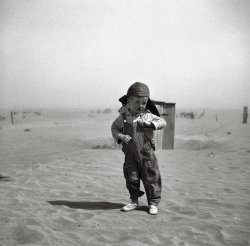
- Winsome Ragamuffins II
- ... his sister. 35mm nitrate negative by John Vachon for the Farm Security Administration. View full size.
Better! They look a lot ... Posted by Dave - 09/03/2010 - 2:39am -
![Winsome Ragamuffins II April 1940. Dubuque, Iowa. "Children who live in the slums." Our second look at this towheaded twosome, a sort of proto-Opie and his sister. 35mm nitrate negative by John Vachon for the Farm Security Administration. View full size.
Better!They look a lot happier here. Why does that comfort me?
Also? Check out the buckles on the little girl's shoes. FABULOUS. I'll bet she loved them.
We Were Poorbut we didn't know any better. This photograph is definitely my favorite of the two. It's showing them with a winning smile and a "we can make a better future" look, which is what America is all about.
Cute kidsSince the first picture of these kids I've wondered if maybe the photographer dirtied their faces up for effect. Guess I'm of a cynical nature.
[You should read up on John Vachon. - Dave]
Re: Cute KidsMaybe the dirt is the reason for their smiles, no? All these years removed, it's not always easy to remember the fun of being carefree, running and exploring the outdoors from sun up to sundown -- but it's there, tucked away. Something tells me there was no need for the photographer to apply any more dirt than was already on those adorable faces!
Sad or happy, these children tug at my heartstrings!
Not always a hindranceMy mother, born in 1919, grew up poor and also with a crossed eye, she always said it developed her backbone in life. My father found a doctor in 1957 to correct it. Many photographs later she was convinced it was fixed.
SweetThe reason my eyes tear up when I look at this photograph is because it makes me remember how sweet and innocent my own children where at that age.
Texas CitrusWhat a neat connection with the pictures of the other children from Weslaco & Harlingen, Texas, posted earlier. That fruit box is from the Rio Grande Valley, maybe even from the farms/orchards worked by the FSA workers. Small world.
One day at a timeI'm convinced this is a young Bonnie Franklin.
These children were loved.These children may not have lived in the best house in town, but they look well-fed and adequately clothed and shod. Believe their parents did what it took to keep those little folks cared for and cared about. And I weep for my little children, who always lived in a nice house and always had at least enough, but whose mother abandoned them years ago, when my daughter was 8 and my little fellow 5.
(The Gallery, John Vachon, Kids)](https://www.shorpy.com/files/images/8a05452a2.thumbnail.jpg)
- Summer Internees: 1942
- ... CCC camp now under FSA management. Japanese-American farm workers swimming." Medium format nitrate negative by Russell Lee for the Farm Security Administration. View full size.
Beam me up! The an on the ... Posted by Dave - 08/21/2012 - 8:34pm -
![Summer Internees: 1942 July 1942. "Rupert, Idaho. Former CCC camp now under FSA management. Japanese-American farm workers swimming." Medium format nitrate negative by Russell Lee for the Farm Security Administration. View full size.
Beam me up!The an on the left could be a relative of George Takei. He spent time in an internment camp as a child.
I hope they found some funHard to be happy when your family is interned for no other reason than being Japanese. Unless I have my facts wrong. Good photo though!!
They seem relatively happydespite being interred for no real good reason. I wonder if they were asked to smile for the camera.
[You might want to check the difference between "interred" and "interned." - Dave]
The campsA former Japanese American co-worker said that from her personal experience once people arrived at the internment camps friendships were made and people generally made the best of a terrible situation. She said she met her future husband while there and that her family was able to buy a few simple comforts of home from the Sears and Montgomery Ward catalogues. Many of the San Diego children regularly corresponded with Miss Breed, a kindly downtown librarian who later published some of those letters in a book entitled "Dear Miss Breed." She remained close to some of those former children the rest of her life.
Bathing BeautiesFinally some bathing beauties I can appreciate. hubba hubba!
(The Gallery, Relocation Camps, Russell Lee, Swimming, WW2)](https://www.shorpy.com/files/images/SHORPY_8c32564u.thumbnail.jpg)
- Li'l Skeptics: 1943
- ... 1940; by the time Esther went to work for him in 1942, the Farm Security Administration had been absorbed into the Office of War Information. ... Posted by Dave - 09/13/2011 - 1:55pm -
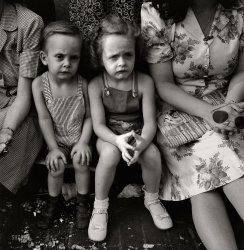
- Country Barber: 1941
- ... Heard County, Georgia." Photo by Jack Delano for the Farm Security Administration. View full size.
Maybe there's one just ... Posted by Dave - 06/28/2021 - 4:35pm -
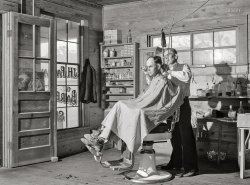
- Bisbee, Az.: 1940
- ... Copper mining center." Photo by Russell Lee for the Farm Security Administration. View full size.
Updated streetlight The ... Posted by Dave - 08/08/2018 - 1:54pm -
![Bisbee, Az.: 1940 May 1940. "Side street [Subway Street] of Bisbee, Arizona. Copper mining center." Photo by Russell Lee for the Farm Security Administration. View full size.
Updated streetlightThe incandescent streetlight was undoubtedly converted from an arc light, which had to be maintained several times a week.
Zephyr!Holy Moly, a 1939 Lincoln Zephyr Coupe parked in front of the jewelers sign. Flathead V12 power!
Likely very old train tracksI think those tracks are from the original El Paso & SouthWestern (EPSW) rail to Bisbee. The trolley tracks ran along Main Street.
[The EPSW line would not have gone through the business district. Bisbee was served by both a streetcar system, with much trackage re-laid and embedded in concrete in 1920, and the Warren-Bisbee Railway, an interurban trolley with service to the nearby town of Warren. - Dave]
Now (2016) with Air Conditioning
66 years of public service . . . make 100 cigarettesI was intrigued by what was visible on a distant building, and quickly found the full text of the Bull Durham roll-your-own pitch. They seem to have been counting years starting from around 1860, which means the sign had been there a while when Lee took this photo.
Near 8 Subway StFrom research with Bing Maps, I was surmise we are near 8 Subway Street.
It's amazing how many structures are recognizable today. For example, the corner curb steps on the sidewalk are still there.
One interesting detail that seems to be gone is the abandoned RR siding track buried in the street. It would be interesting to know which building(s) had rail service, and why.
Also absent is the quaint streetlight mounted on a pulley-and-rope system so that it can be lowered to change the bulb.
So that's what that area was for!I just knew it as an unusually wide alleyway behind Main Street, which is well out of frame to the left.
The first storefront on the right beyond the telephone pole now houses (or did in May 2013, when I was there) a little vintage kids toys/antique shop -- picked up a pretty fair stack of western swing 78's there, too.
To the left, the L.L. Gilman Jeweler's building now houses a gigantic antique shop. 3 floors (including basement) packed to the gills with just about any vintage knick knack you'd want if you've got the money. Place still has an intact vault where they keep all the records (yes, I'm a 78rpm record collector).
Also, about 200 feet behind and around 50 feet up a set of steps to the left as you're facing it is the relatively posh Copper Queen Hotel - a 4-story affair that holds the distinction of being the longest continually operating hotel in the state of Arizona (opened 1902).
Back-Alley AblutionsSubway Street's namesake is the Subway, a large subterranean drainage channel paralleling Main Street. After a series of devastating floods, Bisbee thoroughfares including Subway and Main were reconfigured and paved with concrete to serve as spillways during the monsoon season:
Ghost SignIf you go backwards a little on the Google Street View (click the arrow pointing towards you), you can still see white painted lettering above the Bisbee Antiques sign on the brick building towards the left. I believe I can make out the "Gilman" and "Jeweler" shown in the 1940 photo. In fact, the darker brick color seems to appear only where the original painted sign once was.
38 Zephyr I believe the Zephyr is a 1938. The trunk handle is above the license plate. I'm probably wrong, but that's what it looks like.
(The Gallery, Mining, Russell Lee, Small Towns, Stores & Markets)](https://www.shorpy.com/files/images/SHORPY-8b24907a1_Bisbee.thumbnail.jpg)
- Local Heroes: 1940
- ... Dakota." 35mm nitrate negative by John Vachon for the Farm Security Administration. View full size.
Wonder if it was a Friday ... Posted by Dave - 08/14/2012 - 5:00am -
![Local Heroes: 1940 October 1940. "Football players. Minot, North Dakota." 35mm nitrate negative by John Vachon for the Farm Security Administration. View full size.
Wonder if it was a Friday night?Did a bit of poking around this morning on Google Earth, and I think this might be the same spot on Main Street.
No Spoiled JocksI'm guessing that in 1940 they were not provided with rides to and from the games but one would think the guy on the right would have taken his helmet off at least to walk down Main Street. Or perhaps they were in a parade or downtown pep rally.
Vertical HoldPrecursor to the early 1960s Denver Broncos vertical-striped socks. Yikes.
The Three MagiI would guess this photo was taken on the afternoon of October 18, 1940, before the Minot High Magicians lost 28-6 to the Bismarck Demons. Minot High had designated Oct. 18 as "Loyalty Day," involving Homecoming-like events. Going into the game, the Maroon-and-Gold Magicians (or "Magi" for short) were tied with Bismarck atop their division of the East-West Conference. With the possible exception of the next week's game against Williston, this was the only home game for the Magicians in October 1940. (They were only one of four football teams playing in Minot then. The others were the Minot Model High Beaver Kits, the St. Leo Lions, and a college team, the Minot Beavers. It is possible that these were players from one of those teams, but even in black-and white that sure looks like maroon and gold.)
So UncoolIn the late 1950s Baltimore, walking around town, or even your own 'hood, in your football togs, was seriously frowned upon by your peers. The guy on the right goes the extra mile, even wearing his hat. Sheesh.
[Ever wear a football hat yourself? Just wondering. - Dave]
Before GPS"I thought you said the stadium was over here!"
VarietyWe've seen a few of Vachon's photos [155. - Dave]; he had an interesting choice of subjects. The high, diorama like shots, then interesting signage and people. Nothing specific, like he looked up and there these three were, just trudging along. Spontaneous reaction shot. Same with the shot of the two kids coming home from school down that snow covered road.
(The Gallery, John Vachon, Sports)](https://www.shorpy.com/files/images/SHORPY_8a32660a.thumbnail.jpg)
- Bovey Blasters: 1941
- ... Medium format acetate negative by John Vachon for the Farm Security Administration. View full size.
Light 'em up if you got ... Posted by Dave - 03/22/2020 - 4:54pm -
![Bovey Blasters: 1941 August 1941. "Blasting crew in the Danube iron mine. Bovey, Minnesota." Medium format acetate negative by John Vachon for the Farm Security Administration. View full size.
Light 'em up if you got 'emOh wait -- maybe that's why they're all using chewing tobacco.
SnooseSnus or snoose would be the local name for what's in those cans; a very common Scandanavian habit here back in the day.
RequirementWanted: Blast crew members. Must wear glasses. All others need not apply.
[The identical safety specs they're wearing are indeed mandatory. - Dave]
Snuff cansor hockey pucks in their shirts. I'm betting on "Red Man".
Or TapeAs a longtime snuff chewer, I would agree that those are most likely smokeless tobacco cans, but there's a good possibility that those are rolls of electrical or friction tape, used to splice wire.
Safety glassesAnd I thought they were a gathering of the Robert Woolsey fan club!
GrouchosThese cowboys look like they know how to joke and take a joke. I wouldn't be surprised if they had all put Groucho mustaches under their safety glasses for this picture.
Safety SpecsI have a very similar pair that belonged to my grandfather. He was a machinist during the run-up to WW2. If memory serves me the lenses are ground from quartz. My grandfather's pair has a deep scratch that was caused by something in a metal lathe shattering and the pieces flying everywhere. Better a scratched lens than a missing eye.
Happy BunchA really happy bunch. They get to blow things up!
Those aren't tobacco cansThey are the tins that held the blasting caps that fired the dynamite. I remember my dad had his shot papers to shoot underground dynamite.
(The Gallery, John Vachon, Mining)](https://www.shorpy.com/files/images/SHORPY-8c20442a.thumbnail.jpg)
- The Whitfields: 1939
- ... size. 35mm nitrate negative by Dorothea Lange for the Farm Security Administration.
Daddy's little girl I bet he didn't spoil ... Posted by Dave - 09/09/2011 - 11:48am -
![The Whitfields: 1939 July 1939. "Tobacco sharecropper's house. White family. Rural rehabilitation clients. Whitfield family. Near Gordonton, North Carolina." View full size. 35mm nitrate negative by Dorothea Lange for the Farm Security Administration.
Daddy's little girlI bet he didn't spoil her (much).
CropsSomeone was asking about the crops grown here.
Gordonton is in Person Co., not too far from Granville Co.
Rural RehabilitationInteresting caption. But just what are rural rehabilitation clients? Sounds like a classification that a federal bureaucrat would come up with!
[Google books link - Dave]
A roving eyeShe's grown heavy from having four children and tries to keep her family and herself looking nice. He has a roving eye and considers himself quite a dandy. He holds his cigarette the way the guys in the movies do. He'll go away before long. Interesting that the brim of his hat echoes the roofline, wavy and worn.
(The Gallery, Dorothea Lange, Kids, Rural America)](https://www.shorpy.com/files/images/8b33811u.thumbnail.jpg)
- Man of Tin: 1941
- ... Pennsylvania." Acetate negative by Jack Delano for the Farm Security Administration. View full size.
Lil’ Warshington So known ... Posted by Dave - 04/02/2022 - 11:40am -
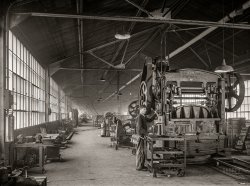
- Egg Grid: 1942
- ... Medium format acetate negative by Russell Lee for the Farm Security Administration. View full size.
Well ... That's gross.
... Posted by Dave - 04/29/2022 - 10:16am -
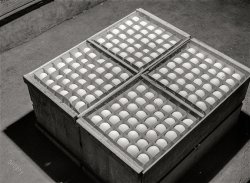
- Askew-Trippe Furniture: 1941
- ... Medium format acetate negative by Jack Delano for the Farm Security Administration. View full size.
Could be a Furnace store We ... Posted by Dave - 11/04/2019 - 10:46am -
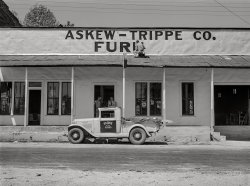
- Rancho Glutenous: 1941
- ... format acetate negative by Marion Post Wolcott for the Farm Security Administration. View full size.
"Ranch" ?? You ... Posted by Dave - 09/17/2019 - 7:15pm -
![Rancho Glutenous: 1941 August 1941. "Harvesting wheat with combines on Schnitzler Corporation ranch at Froid, Montana. There are about 2,800 acres on this part of the ranch and they are getting over forty bushels to the acre. It is one of the largest wheat ranches in the West." Medium format acetate negative by Marion Post Wolcott for the Farm Security Administration. View full size.
"Ranch" ?? You would be hard pressed to find a grain farmer who would refer to his farm as a ranch, "farm" would be the term, "wheat ranch'' ? C'mon.
[Scroll up. - Dave]
Forecast - hot and dryHaving spent a bit of time in wheat country, I look at this picture and can relive exactly how it looks, feels, smells, and sounds. You have to squint a bit because in the direction of the light tan wheat, with shiny stalks, it's really bright, it's hot and and (perpetually) windy, there's a smell of dust and the unmistakable smell of the moisture sucked up that is getting released as it's cut. There's a very "large" silence with rustling wheat from the wind, with the sound of the tractor a tiny source in a huge, huge space.
Cold by any other nameHad to chuckle when I realized the bad advertising involved in naming Froid, Montana. Froid (pronounced fwad) is the French word for "cold", which is appropriate for winter in Montana. Maybe it was a Froid-ien slip.
The combiner ...... seems to be a McCormick-Deering No 31-T Harvester-Thresher.
Ranch!It seems the family referred to it as a ranch as well, at least per this obituary for a family member "She was raised in Froid, devoted to her father who was a leading newspaperman, wheat rancher, banker and state senator."
Source: https://www.bozemandailychronicle.com/obituaries/obituary/article_b46635...
(The Gallery, Agriculture, Landscapes, M.P. Wolcott)](https://www.shorpy.com/files/images/SHORPY-8c15322a.thumbnail.jpg)
- Little Boy Blue: 1941
- ... Medium format acetate negative by John Vachon for the Farm Security Administration. View full size.
Below decks The very best ... Posted by Dave - 03/18/2020 - 2:44pm -
![Little Boy Blue: 1941 August 1941. "Son of Mr. Nichols, defense worker from Cass City, Michigan, now living in a trailer at Edgewater Park near Ypsilanti. Mr. Nichols works in the Ford bomber plant." Medium format acetate negative by John Vachon for the Farm Security Administration. View full size.
Below decksThe very best in the design of yacht interiors. Oh, it’s a trailer? Whatever. And such beautiful grain in the plywood. And a cute (albeit sad) kid.
Sit this wayThe reason the boy is sad is likely from the task of having to follow the directions of the photographer and his mother. He probably hated the whole ordeal and just couldn’t wait to get back outside and play where there were no adults. Poor lad.
The Shadow knowsthat all you need for mystery and suspense is a small breeze and a warm radio.
The thing above the valanceMany RVs from the 60s on have built-in entertainment systems, but I've never seen a pre-war unit with one. If that's what it is, then the small bakelite radio below is like what I remember from many basements in the 70s: a small TV, set atop a larger wood cabinet TV that had stopped working.
What is that top dial?I see the bottom table top radio but what is that top dial about?
Don't touch that dial!The interesting thing here is that there is what appears to be another radio (or some other electronic equipment) directly above the while marble radio in the center. I cannot read the make or model for either the upper or lower device. Perhaps someone with expertise in radios of this era can identify them. The upper one looks to have several bands.
It's placed so high that the morose young man certainly cannot touch it, but it's also above what I expect would be the parents' comfortable reach as well. Also intriguing are the paper cards marked "RECEIVED" that are blocking the speaker grille. Does the radio still work?
Questionable designWhat's with the cabinet above the radio and fan? To the left: an instrument that's hard to read with 4 knobs that are hard to reach. To the right: an awkward place to store receipts.
Two radios doesn't make it stereo.They built an old Montgomery Ward Airline brand AM & shortwave band radio into the space above, but have a newer General Electric H-500 model AM-only radio on the counter.
That upper radioThanks Wiscojim for identifying the radios. You can see a see a nice picture of the GE H-500 here: https://www.radiomuseum.org/r/general_el_h500.html . As for the Montgomery Ward Airline, that is quite interesting. The Airline was a very long-lived brand - and was quite diverse, as you can see here:
https://radioatticarchives.com/archive.htm?page=a4#Airlin
Looking at the dial, the one here seems to be the closest match for the 62-196,
https://www.radiomuseum.org/r/montgomery_62_196_1.html
https://radioatticarchives.com/radio.htm?radio=5810
which was a rather handsome tombstone three-band unit before it was dissected.
Beetle GE General Electric H 500The Classic Radio Gallery informs us about the plastics used in radio cabinet construction. The GE H 500 radio, also known as the GE "Turbine", has a housing of Beetle plastic, a trade name used by the American Cyanide Cyanamide Co.
["American Cyanide"? Um, no. - Dave]
[Um, I see: do not quote without checking the quote itself, thnx Dave - Alex
(The Gallery, John Vachon, Kids)](https://www.shorpy.com/files/images/SHORPY-8c20120a.thumbnail.jpg)
- Twin Cities Trucker: 1939
- ... Medium format acetate negative by John Vachon for the Farm Security Administration. View full size.
Pre Aerosol Graffiti I see ... Posted by Dave - 05/18/2020 - 1:17pm -
![Twin Cities Trucker: 1939 September 1939. "Truck driver who operates between Twin Cities and radius of 150 miles tying in load. Minneapolis, Minnesota." Medium format acetate negative by John Vachon for the Farm Security Administration. View full size.
Pre Aerosol Graffiti I see the street artist of the time had to use sidewalk chalk for their tagging. Or, are those rail hobo telegraph messages?
[Routing designations scrawled by railyard switchmen. -Dave]
Independent TruckerThis is a good example of how independent owner-operated trucking worked back then. Licensed and regulated trucking companies and union drivers would have referred to him as a "gypsy."
If you had a large enough freight shipment, it would be much cheaper to just "rent" a boxcar from the railroad and be responsible for loading and unloading it yourself. The railroad would park the car on a "public" or "team" track, and you would "release" it to the railroad when it was loaded and ready to move, and when unloaded at the destination and available for reassignment. You had a limited time to hold the car at each end without incurring extra charges called "demurrage." You could save even more by having a one-person delivery service like this one to unload it for you if you couldn't do it yourself.
My great-grandparents used this method circa 1895, when they moved 75 miles from Darlington to Columbia, South Carolina. It was the only way to do it then, since roads (and trucks) did not yet exist.
Safety CabWhen your brakes are unreliable, it's important to be able to jump out quickly!
Thisis N.P.R.
Trucker's Hitch?I'm curious how the tension on this load is maintained. Is it possible that a "trucker's hitch" is applied on the opposite side of the vehicle?
Insulation for Minnesota wintersThese are Gimco rock wool insulated batts. Rock wool has traditionally been made by melting down basalt stone and recycled slag from steel mills.
Interesting article about it here:
https://www.familyhandyman.com/walls/mineral-wool-insulation-is-making-a...
He's got a story to tellIf only he could tell about that time he lost the cab's door.
ToastyI'm sure that new Minnesota homeowners will appreciate those "Full Thick Sealal Bats" come wintertime.
Old boxcarsA couple of elderly cars for a 1939 photo. Believe it or not, the one on the right is probably older -- you can see the metal “truss rods” under the floor of the car, a tensioning system to strengthen the wood floor. Unless it had steel members added, most of that car’s structural members are probably wood, while the car on the left lacks the truss, and probably has a steel underframe.
I love the arched “Northern Pacific” lettering -- the kind of thing that vanished as wages rose, because it was harder to do with a single stencil.
(The Gallery, Cars, Trucks, Buses, John Vachon, Minneapolis-St. Paul, Railroads)](https://www.shorpy.com/files/images/SHORPY-8c16935a1.thumbnail.jpg)
- One Way: 1936
- ... Medium format nitrate negative by Carl Mydans for the Farm Security Administration. View full size.
This is Peace Street This ... Posted by Dave - 12/07/2015 - 11:51am -
![One Way: 1936 February 1936. "Narrow street in New Brunswick, New Jersey." That part of town known in many American cities as the Gashouse District. Medium format nitrate negative by Carl Mydans for the Farm Security Administration. View full size.
This is Peace StreetThis would be looking down Peace Street, as Eber's was apparently located at 5-7 Peace Street as per the 1937 city directory.
Despite my best efforts to figure out what happened to it, I couldn't figure out where Peace Street was/is, as it apparently was either renamed or obliterated over time.
All Gone NowThis was looking north up Peace Street toward Albany. (Burnet became Peace at the intersection where this was taken.) Most of this came down in the 50's as part of a roadway expansion, and the rest when what became the Hyatt Regency was built in the early 80's. Hard to believe the gashouse lasted until around 1960!
I remember that building!The tan brick affair (well, I know it was tan but of course it's in black and white here) with arched windows at the end of the street is the Public Service Electric and Gas building. I was born in New Brunswick and I remember it, but I don't remember any narrow street like this opening onto Albany Street where the building was. I also don't remember a fuel storage tank, although it certainly stands to reason one should have been there.
I'm sure the other people who posted comments are right - it is Peace St., which I never heard of. There were very few cobblestoned areas in the New Brunswick I remember, mainly the square by the railroad station.
[The "fuel storage tank" is a gas holder, also called a gasometer. - Dave]
Narrow streetsI lived on Neilson Street in the early 50's. The area wasn't much different then. Most building were torn down in the 60's and replaced with restaurants I can't afford to eat in.
Can't help thinkingphotographically speaking that the original Peace Street was much more interesting than its present incarnation. Packed full of character.
Based on historical aerial photosThe large tank came down between 1957 and 1963. The space it occupied is currently the Johnson & Johnson property (the tank was near the current Johnson Drive on the Route 18 side of the property).
Unfortunate ChangeWhat a remarkable change to the area between then and now. It looks like suburbia today, while in the 1930s it was apparently part of the city center. I can imagine all those old buildings restored, renovated, and in use as a trendy touristy area of shops and eateries.
Tough Work If You Can Get ItIt appears they had no problem getting men to shovel snow during those tough Depression years.
1912 Sanborn map Here is a segment from a 1912 fire insurance map showing Peace Street between Albany and Washington Streets. I think the photographer was at the intersection of Church and Peace looking north. I estimate that the gas tower would have been situated in the vicinity of the '37'.
(The Gallery, Carl Mydans)](https://www.shorpy.com/files/images/SHORPY-8b26917a.thumbnail.jpg)
- Mom-and-Pop: 1939
- ... in their off times." Photo by Dorothea Lange for the Farm Security Administration. View full size.
Name Your Poison Sugar? ... Posted by Dave - 08/21/2014 - 8:42am -
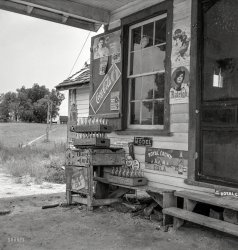
- Tahlequah Revival: 1939
- ... full size. 35mm nitrate negative by Russell Lee for the Farm Security Administration.
Wow, a National (probably) resonator mandolin ... Posted by Dave - 01/01/2009 - 10:34am -
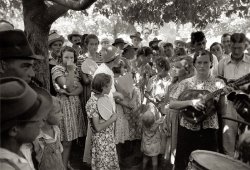
- Crossing Thirteenth: 1939
- ... format acetate negative by David Moffat Myers for the Farm Security Administration. View full size.
Portable camera being held by ... Posted by Dave - 05/15/2019 - 8:31pm -
![Crossing Thirteenth: 1939 Spring 1939. "Waiting for stoplight in Washington, D.C." Medium format acetate negative by David Moffat Myers for the Farm Security Administration. View full size.
Portable camera being held by a woman?Does it seem like the woman to the right of the tall man (on his left) in the center has both her handbag and a portable expanding camera hanging from her left arm?
[A "portable camera" -- i.e., a camera. - Dave]
Dave, shucks, thanks for the clarification - I was trying to be descriptive as more portable than the typical large format flashbulb-equipped, newspaper-type cameras with flash bulbs of that era. After some quick research it appears similar to a camera like an EASTMAN KODAK BROWN SIX-16 FOLDING FILM CAMERA.
Judging from the expressionsI'm guessing most of these folks could use a Dr. Scholl's insert. At some point it became acceptable for people to wear sensible shoes with otherwise business/smart attire when going to and from their place of work. But I'm not sure when.
The good doctorWhen studying marketing in school, I interviewed a old shoe-store manager in Miami who had been called upon by Dr. William Scholl.
He told me the doctor opened his briefcase, took out an articulated human foot skeleton, slapped it on the counter, and said, "As long as people, especially women, buy shoes based on style instead of anatomy, you and I are going to make a lot of money."
On those shoesIf they were truly uncomfortable, I'd expect to see a few of these people rocking back and forth to ease the the soreness. Notice that only one lady is lifting a foot; everybody else is firmly planted. Also, the guy just to the left of the light pole wearing a tweed coat & sweater is wearing "suede bucs", an early version of what I grew up with as "Hush Puppies."
I've actually got a couple of pairs of shoes--Allen Edmonds--made on lasts/designs dating back to about this time, and they're great.
F + 13th streets NWErlebacher's was 1222 F Street; Shenley's hat shop was at 1221 F. There's not a single thing in the photo that's left now.
The honeymoon's over.From the expression on their faces, I'd guess the two on the left had been together for TOO long!
Holy Cow Hats I just noticed that almost everyone captured in this image is wearing a hat. I never knew they were so popular back in the late 1930's. Back then owning a hat factory was like owning the umbrella concession when pigs fly.
Re: F + 13th streets NWThe building in the foreground at the left of the picture is still there. Compare the corner of the building and the piece under the window, it's the same as in the new view.
The streetlight pole... is still there.
Two things left ...at least I believe is the building on the corner behind the people. Though its been likely remodeled it is the same structure. Also the light post, albeit shortened with a new top
(The Gallery, Cars, Trucks, Buses, D.C., David Myers, Streetcars)](https://www.shorpy.com/files/images/SHORPY-8b15288a.thumbnail.jpg)
- Cut Rate Drugs: 1941
- ... Medium format acetate negative by Jack Delano for the Farm Security Administration. View full size.
Is this the spot?
... Posted by Dave - 04/14/2021 - 12:12pm -
![Cut Rate Drugs: 1941 September 1941. "South Royalton, Vermont. Storefronts on the main street." Medium format acetate negative by Jack Delano for the Farm Security Administration. View full size.
Is this the spot?
The brickwork is redone and the building has been renamed, but this could be it.
[It is the same spot but a newer, shorter, building. - Dave]
Belt Drive Drill?Taking a peek through the window of Dr. Dearing's office window I spy something that looks suspiciously like a belt drive dental drill. Those of us of a certain age may not want to be reminded of slow speed drills and a lack of novocaine. I was always fascinated by the spinning belts.
Money Well SpentI've shopped in the last store on the right. I believe the cashier's name is Patreon.
I wonder if that's MartinWatching over his block.
De rigueurOf course Dr. D.E. Dearing was a Dentist. Visiting his office was no doubt de-de-de-delightful.
'59The Martin Block (constructed in 1887 upon the ashes of a fire that destroyed the village's commercial core) was replaced by the Crawford Block in 1959 - the same year that Dr. Dana Emerson Dearing (Tufts College of Dentistry Class of 1904) was laid to rest in the main South Royalton cemetery, a decade after the death of his wife May. Dr. Dearing had been an officer in numerous agricultural or natural associations in the White River valley. (The presence of an IOOF hall, next to the Crawford Block in part of the original 1887 commercial redevelopment that remains standing, makes this an official Shorpy photo.)
Zoot SuiterJust down from the SHORPY What Not Store sits local Zoot Suiter awaiting opening of the cleaners to get his pegged pants pressed.
Reminiscent ofwhat Edward Hopper was intrigued with.
(The Gallery, Jack Delano, Small Towns, Stores & Markets)](https://www.shorpy.com/files/images/SHORPY-8c07143a.thumbnail.jpg)
- Villa Carlesia: 1939
- ... Florida." Acetate negative by Marion Post Wolcott for the Farm Security Administration. View full size.
Could be yours for $27M ... Posted by Dave - 04/27/2021 - 9:31am -
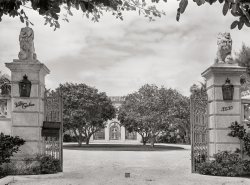
- Hart to Hart: 1941
- ... format acetate negative by Marion Post Wolcott for the Farm Security Administration. View full size.
Just in time for Pearl Harbor ... Posted by Dave - 10/01/2019 - 9:26am -
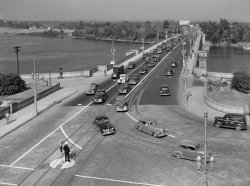
- Tidewater Texaco: 1941
- ... Medium format acetate negative by John Vachon for the Farm Security Administration. View full size.
Match or March I hope it's ... Posted by Dave - 02/12/2021 - 12:19am -
![Tidewater Texaco: 1941 March 1941. "Gas station. King William County, Virginia." Medium format acetate negative by John Vachon for the Farm Security Administration. View full size.
Match or MarchI hope it's not match, given the possibility of fuel present, and the possible significant distance to a fire station ... but at any rate, I love the shepherd's hook signage on this Texaco. When I was little, in the late '50s until the mid '60s, my small family (mom, stepdad, sister, and me) were constantly on the move, virtually itinerant in a stolen baby blue Nash Rambler, in whose back window I slept. I loved rolling into a filling station because once you heard the ding, Mama started looking around for the Coke-Cola machine. I scanned the sky outside my backseat window mile after mile for the big yellow Shell shell, or the red Texaco star, or the green Sinclair dinosaur, or the sinuous Esso logo, hoping that a frosty glass bottle of sodey pop could be in my near future. Fly in the ointment: it saddened (well, angered) me that I always had to share with my big sister. Which meant, grab it out of her hands whenever I had the chance. I don't see refreshments here so let's move on before the whole thing blows sky high.
I’ll have a grape Nehi!The only ads I see. It’s either tires or a Grape Nehi!
Edit: the picture reminds me of the upper peninsula of Michigan.
NokesvillePicryl.com locates this on King Richards Court in Nokesville, which is about 10 miles southwest of Manassas. I do hope that nice big pine tree was spared during the
inevitable urban development and expansion of the roadway.
[Nokesville is in Prince William County. Our photo was taken in King William County, a hundred miles away. - Dave]
Southern PinesThe large pine tree here drew my attention immediately. Having grown up in the south, pines were a part of my existence. We lived in a trailer park that had once been a plantation, now grown over with 50+ year old pine trees that towered over our yards. Each year a storm or a tornado would topple one of these trees and slice through a trailer like a knife through soft butter. Needless to say I grew up with a fear of bad weather.
Rough Neighborhood?Are those bars on all the windows? Seems like a little overkill for a one-pump station out in the sticks. Perhaps running a gas station was a very lucrative enterprise back in the day!
Another Fantastic VachonHis work is consistently amazing to me. For the second time, I purchased a print of his from Shorpy (sorry if that sounds like an endorsement - it is!).
The thing that strikes me (living thirty miles away from this scene, is that I can see the sky at the top of the frame, in a deep blue. Thanks, John Vachon - and Shorpy.
Root 66I thought the same thing re: the iron bars. I wondered briefly whether the filling station housed the jail. Barney Fife would know the answer.
Isolated LocationI was just thinking that the bars on the window were there because otherwise the humble establishment would be a softer target. I imagine when the shop closed up it didn't have the benefit of nearby buildings or persons who could witness a break in by someone traveling by.
(The Gallery, Gas Stations, John Vachon)](https://www.shorpy.com/files/images/SHORPY-8c19157a.thumbnail.jpg)
- Back at the Diner: 1939
- ... full size. 35mm nitrate negative by Russell Lee for the Farm Security Administration.
Kellogg's Krumbles The cereal box between ... Posted by Dave - 06/17/2008 - 12:13pm -
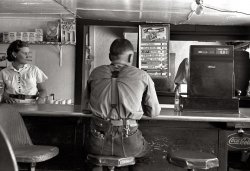
- The Wonder of It All: 1938
- ... parade. Crowley, Louisiana." Photo by Russell Lee for the Farm Security Administration. View full size.
Enchanting I'd bet a pound ... Posted by Dave - 03/05/2012 - 4:38pm -
![The Wonder of It All: 1938 October 1938. "Boys at the National Rice Festival parade. Crowley, Louisiana." Photo by Russell Lee for the Farm Security Administration. View full size.
EnchantingI'd bet a pound of Popcorn rice that this is their first date.
Look! Up in the sky!It's a bird! It's a plane! It's....
3 of a kindThey look like brothers to me.
The Rice Festival is still held in Crowley, La.
HmmmThey look very much like brothers!!!
The Middle boyI suspect from his lack of expression, that the middle boy is blind and the boy on the left is explaining what's happening.
TheoriesThe rice straw is most probably on a float, as in the picture of the contestants. So these boys were either on a float or next to one. Given the pose, and the laughing third boy, I think they were hamming it up for the camera. Perhaps an exaggerated gaze and stance which drew a chuckle from number three.
[It's a fence lining the parade route. - Dave]
A Woman to BlameI believe the guys are trying to impress, amuse or aggravate a girl or a group of girls just out of the picture. All worthy causes for boys of that age group.
A case of conjoined twinswith older brother as escort sporting teeth as nice as photos in a dentist's office.
Small TownCrowley couldn't have been a very big place in 1938 (or 2012 for that matter.) Perhaps someone from there actually knew these guys and could provide their story; I also agree that the 2 on the left are very likely brothers.
(The Gallery, Russell Lee, Small Towns)](https://www.shorpy.com/files/images/SHORPY_8a24098a.thumbnail.jpg)
- F.W. Woolworth: 1940
- ... Indiana." 35mm nitrate negative by John Vachon for the Farm Security Administration. View full size.
I grew up on the far I ... Posted by Dave - 02/18/2012 - 3:00pm -
![F.W. Woolworth: 1940 May 1940. "Woolworth Company, Indianapolis, Indiana." 35mm nitrate negative by John Vachon for the Farm Security Administration. View full size.
I grew up on the far I grew up on the far eastside of Indpls and remember the day the Grant building was on fire. I came home from school and it was all over the news, I was young and got the impression the whole downtown was on fire.
CrispThe Woolworth facade is like the crisp dollar bill you find in the middle of the worn and well circulated dollar bills in your wallet.
ConflagrationThe left-most structure was the Thomas Building. It and the Grant building adjacent to it were consumed by a massive fire in November 1973. In all, 15 buildings were either destroyed or damaged.
http://digitallibrary.imcpl.org/ffm/ffmGrant.php
By this time the Woolworth building had become the Kirk Furniture building. Today it houses a Buffalo Wild Wings. The brick building to its right was then called the MNB building and still stands.
This photo shows the backside of the Grant buiding as the fire raged:
Calling Dr. FreudNow there is a building with an inferiority complex!
A Rose Between Two ThornsI don't know what style of architecture that is, but I sure do like it! Those sleek lines and shiny facade just make you want to go in and shop for some moth balls and shaving cream, then wind up at the lunch counter for a burger!
[This is Art Deco style. - tterrace]
Thanks! I thought it was. It looks like what the future should have been!
Still there today!This beautiful Art Deco building is still standing, as is the one to the right of it. I was admiring the Shorpy version of the building and, when I saw on Street View it is now Buffalo Wild Wings, realized I've been inside it!
(The Gallery, Indianapolis, John Vachon, Stores & Markets)](https://www.shorpy.com/files/images/SHORPY_8a06297a.thumbnail.jpg)
- The Peanut Gallery: 1939
- ... had ever attended school." Photo by Russell Lee for the Farm Security Administration. View full size.
Boy trouble The two on the ... Posted by Dave - 03/27/2018 - 10:48am -
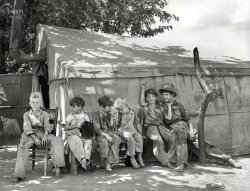
- Cold Drinks: 1938
- ... Donaldsonville, Louisiana." 35mm negative by Russell Lee, Farm Security Administration. View full size.
It likes you The sight of ... Posted by Dave - 05/30/2015 - 8:46pm -
![Cold Drinks: 1938 October 1938. "Ice at refreshment stand, state fair, Donaldsonville, Louisiana." 35mm negative by Russell Lee, Farm Security Administration. View full size.
It likes youThe sight of that bottle always made me happy. And it wasn't the lady with bubbles, which was gone by my day. Maybe it was the green, maybe it was the magic number.
[Another thing: If my circa 1963 childhood memory serves, it used to taste better. - Dave]
Good for stomach miserySoda crackers and 7-Up: good for the upset stomach, at least back when I was kid. Mama's remedy.
We Don't Know... where Mom is, but we've got "Pop" on ice!
Stomach settling In the South, soda crackers and pop as a stomach remedy is still used: Three or four Saltines and a glass of either 7-Up or ginger ale. I still do it and I bet my granddaughters are dosed in that fashion, because my kids certainly were.
Funny! Seems to work somehow and does no harm.
7-Up slogan & bottle -- fond memoriesI spent more hours in a bar at age 4 than I have in my entire adult life. My dad would stop at a friend's tavern and have a beer, and I would always have a 7-Up sitting next to him.
I have to confess that exposure to this environment at such a tender age has resulted in my being somewhat of a lush in my senior years -- on average, I now consume one beer a month.
The original pic is sure a great one; I remember as a kid drinking the 6-ounce Cokes from the old greenish "hoopskirt" style bottles.
I certainly regret not taking a store owner up on the offer of "taking an old Coke machine" for free when I was about 16 years old. It was probably a Vendo Model 3. I wish I had the machine today!
Barrel on the leftIs that Moxie?
7-Up and soda crackers makes bicarbonate of soda. Makes you burp and settles your stomach.
Very relaxing...This was when 7-Up really did like you a lot - it contained lithium citrate, a mood stabilizer until 1948.
I agree, DaveI bought a 6-pack of 7-Up recently. It tastes fizzy and very little citrus taste. It's nothing like it used to be. 1956 era here.
Ice Bucket Challenge ???Looks like they already were ready for Ice Bucket Challenge ...
Drinks on the left are...Delaware Punch
(The Gallery, Russell Lee)](https://www.shorpy.com/files/images/SHORPY-8a24030a.thumbnail.jpg)
- City Sidewalks: 1940
- ... full size. 35mm nitrate negative by John Vachon for the Farm Security Administration.
Cake Sign I can't seem to get the pictures as ... Posted by Dave - 12/30/2007 - 10:47pm -
